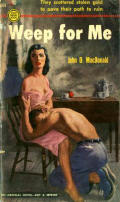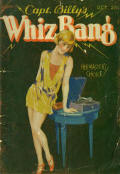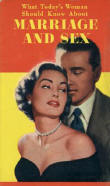 |
Gold Medal | |
|
Click the group of books beginning with number:
|
These were not the
first paperbacks printed in America, and probably not the best ... but
Gold Medal was quite possibly the most important publishing house of the
vintage period. It happened this way: From before 1920, Wilford Fawcett built a magazine and comic book empire that included Mechanix Illustrated, True, True Confessions, Captain Marvel, and many, many others. Wilford liked to call himself "Captain Billy," a moniker he used to produce Fawcett's first periodical, the immensely popular humor magazine Captain Billy's Whiz Bang in 1919. Wilford died in 1940, leaving the publishing giant in the hands of his four sons. In 1949, Fawcett Publications, which was an independent distributor, made an historic agreement with New American Library to distribute Signet and Mentor books at the same locations it sold its magazines and comic books. One of the stipulations of the deal was that Fawcett could not compete with NAL by publishing their own paperback reprints. Roscoe Fawcett (who is credited with the idea of Captain Marvel and other Fawcett innovations), desperately wanted to enter the paperback market. But how could he do so without breaking the NAL agreement? The answer was the Paperback Original (PBO); that is, they wouldn't compete with "paperback reprints;" they would produce titles that had never before been released. This was not the first time PBOs had been printed, but it would be the first time that a paperback publishing house would release ONLY original works; a significant precedence in the annals of U.S. literary history.
John D. MacDonald, Richard S. Prather, Richard Himmel, Vin Packer, David
Goodis, Ann Bannon, Stephen Marlowe, Charles Williams, Wade Miller, Edward
S. Aarons, and many, many others wrote PBO’s for Gold Medal. The Fawcetts first tested the waters by printing two paperbacks that were compilations from True and True Confessions magazines (both Fawcett publications); and while unnumbered, they are now referred to as Gold Medals #99 and #100. When NAL failed to challenge the books, they started printing Gold Medals in earnest. The first book in the familiar format is #101. By odd coincidence, they were exactly the same size as NAL's books, so they fit perfectly on the same book racks that Fawcett was already stocking in their distribution locations. Gold Medals are probably the best looking series of books on the shelf. They are extremely uniform in width, ranging from about 125 to 175 pages. Like Signets, then, the publisher was able to set pretty strict limits on its authors. While the books were not legally “abridged,” we must assume these originals were at least heavily edited. The books’ format did not change at all throughout the first 900 - 1,000 books in the run (with the exception of a very few “wrap around” covers), and so the little Gold Medal colophons line up perfectly on a row of books. Bibliophiles love a neat, orderly existence. I would hate to have made my living as a brassiere salesman to Gold Medal models. The publisher had a staff of artists, and the cover themes tended to be as sexy as possible. Sex sells, and Gold Medal sold an awful lot of books. Gold Medal's first 35¢ series consisted of the Red Seal books. Later, the "G" and "S" books (both 35¢ offerings) were interspersed in the original series in numerical order. The 50¢ "D" and 40¢ "K" books were printed after about 1962. The Premier label featured Gold Medal's non-fiction books. When the deal with NAL finally expired, Fawcett began publishing paperback reprints under the Crest label (click HERE). NOTE: Grant Thiessen says: All 35¢ Gold Medal overprints were done for distribution in Canada.
RED SEAL books were clearly part of the Gold Medal imprint. To view Fawcett CREST books, click HERE. To view Fawcett PREMIER books, click HERE.
This page was updated in January, 2020
|



